Recently, a man from southwestern Missouri died hours after being bitten by what authorities believe was a venomous cottonmouth snake. The man had waded into a river and was bitten on each leg. Despite pleas from his girlfriend to get medical attention, the man refused. Later in the evening, the girlfriend noticed his condition was deteriorating as he was lethargic, confused and had labored breathing. By the next morning, the man was dead.
This story is frightening, but the reality is death from snakebite is very rare. Nevertheless, this article provides a great run down on Missouri snake safety.
Missouri has 47 species and sub species of snakes, but 88 percent of them are harmless. There are only five venomous snakes native to Missouri, they are (in order of most toxic to least toxic):
- Timber Rattlesnake (largest venomous snake)
- Cottonmouth (water moccasin)
- Massasauga Rattlesnake (endangered)
- Copperhead (most common)
All Missouri venomous snakes are members of the pit viper family and have specific characteristics, including: pits located between the eye and nostril on each side of the head, well developed fangs, pupils shaped as vertical slits, and a single row of scales along the underside of the tail. Non-venomous snakes have round pupils and a double row of scales along the underside of the tail.
Anyone can be bitten if they accidentally step on a snake. But, the majority of snake bites occur when a person tries to catch or kill a snake. The typical snake bite victim is a male between 17 and 27, and alcohol is usually a contributing factor.
The seriousness of a venomous snake bite depends on several factors. First, and most important, is the victim’s sensitivity to the venom. Some people are more allergic to snake venom, just the same way some people have more serious reactions to insect stings. People with compromised immune systems, the very young or very old may also have more severe reactions. Second, the venom toxicity level varies greatly between snakes. Missouri’s most common venomous snake, the copperhead, has the least toxic venom of the five venomous snakes in the state. Next, the location of the bite is also important. The least serious locations are the hands and feet, which is good because these are the most common bite areas. Finally, not seeking medical attention is a serious mistake. Even if the bite doesn’t deliver enough venom to kill immediately, it can lead to life threatening infection if left untreated.
If you or someone you are with is bitten, take the following precautions:
- Move out of striking range of the snake.
- Remain calm and minimize physical activity. Excitement and exercise increase blood flow and spread the venom, if any is present. (Remember, there’s a one-in-four chance you got a dry bite!)
- DO NOT try to capture or kill the snake. Medical treatment will be the same regardless of the type of snake that bit you.
- Remove rings, watches and restrictive clothing in case swelling occurs, and rinse off any venom on the skin around the bite.
- Immobilize the bitten area to minimize venom spread.
- Go to the NEAREST doctor or medical facility. Call for emergency assistance if this will speed up transportation.
- Call ahead to the medical facility so they can have the necessary drugs on hand.
Do Not:
- Apply ice to the bite.
- Cut the wound or attempt to remove/suck out venom.
- Apply a tourniquet or constricting bands.
- Use an electrical device to shock the bite.
- Drink alcohol or caffeinated beverages.
It is best to avoid up-close encounters with snakes. In general they are afraid of humans and, if shown an exit, they will take it. Here are some ways to reduce the already tiny risk of snakebite.
- Learn to identify venomous snakes, and know their habits.
- Never handle venomous snakes.
- When possible, delay work until snakes’ inactive period from November through March.
- Wear boots and heavy trousers when working or hiking in areas where snakes live.
- Wear a heavy, long-sleeved shirt and leather gloves when you must work with your hands around rock piles or other snake habitat.
- Use a pole, rake, stick, etc. to probe snake-prone areas before starting work.
- Work or hike with other people for mutual aid in case of emergency.














